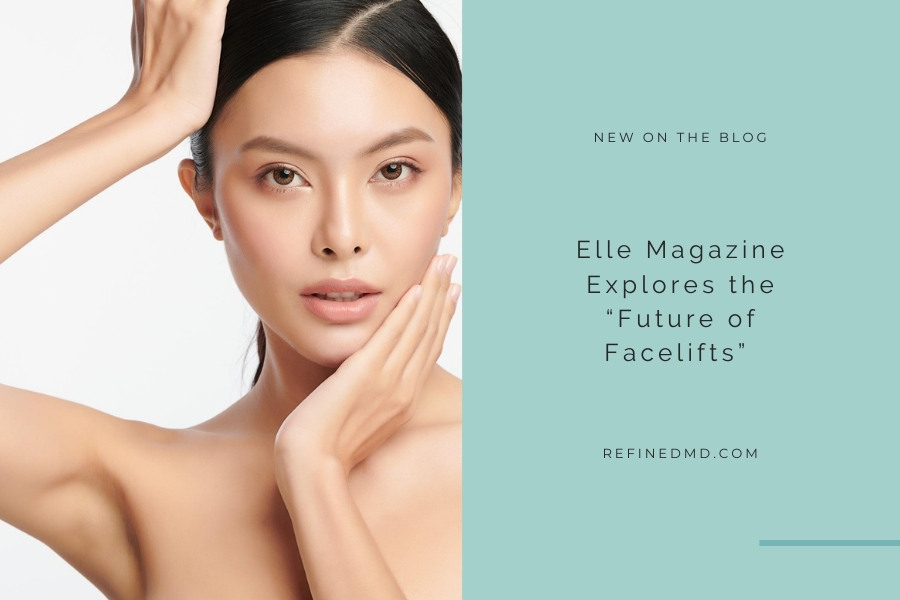
24 Oct Elle Magazine Explores the “Future of Facelifts”
Just like any other procedure, the techniques and technologies behind facelifts are constantly evolving. It is one of the most-requested cosmetic surgeries at RefinedMD where both a full facelift and mini facelift are available (the latter being a good option for those who don’t ‘need a full facelift yet—or want to delay one by several years). Elle magazine recently analyzed the history of facelifts and what the future has in store for this popular procedure. Sabrina Rinaldi shared that at 44 years old, cosmetic surgery started to be the only kind of procedure that really worked anymore. She had depended strictly on dermal fillers and non-surgical procedure and treatments for years, but there comes a time that surgical intervention is going to be necessary to get the results you want.
Rinaldi, a makeup artist, credits her surgeries—including a facelift, rhinoplasty, and breast augmentation—for the confidence boost she has experienced, comparing the procedures to an extension of makeup. She says, “I can contour my face with makeup, and I can also contour my face with surgery. The two go hand in hand.” Rinaldi hopes that the normalization of plastic surgery continues in its current trajectory. It’s not nearly as taboo as it used to be, but it’s still not often discussed openly.
Why One Patient Made the Switch
After years of dermal fillers, Rinaldi experienced a “compounding” of the hyaluronic acid. She tried to have her fillers dissolved with hyaluronidase, but it didn’t work (dissolving fillers is much less a sure thing than injecting fillers). Ultimately, her doctor told her that she would need to have the fillers surgically removed. However, she knew that what she really wanted was to get back to her true self, realizing that too much filler was giving her a “different face.” According to Rinaldi, “I wanted my face; I wanted to go back to what my face was—just a tighter version.”
She is not the only one to undergo what some doctors call “filler fatigue.” Small amounts of filler injected in the right place at the right time can yield positive results for years. However, overfilling is dangerous, and it’s unfortunately very common. For those who are constantly over-filled or over-injected, the results start to look different than they used to (and far from natural). Facelifts can fix this issue, removing compounded fillers while bringing back natural symmetry. Of course, an added benefit of a facelift is a more youthful appearance, with a full facelift turning back the clock 10+ years on average.
The New Face of Facelifts
Rinaldi getting a facelift in her 40s might not be what many think when picturing the typical facelift patient, but there are more and more patients opting for this surgery in this age range. She says, “The mainstream idea around a facelift is that you wait until you’re in your 60s, when everything is fully snagged, and then you snatch it up.” But why wait? Rinaldi enjoys the idea of getting everything tightened up relatively early so that she can age with the face she knows and loves. Facelift results can last anywhere from 10 – 20 years on average, so getting a facelift when you’re younger can be seen as a sort of strategy. Some might be better suited to a mini lift, a form of “pre-juvenation.”
A lot of the time, combining surgical and non-surgical treatments can be the best approach. For example, a lift or mini lift with laser skin rejuvenation can take results to the next level. Surgery only addresses skin laxity, but lasers can affect the quality of the skin itself. You don’t want tauter skin that is still plagued by sun damage. Plus, lasers can also help heal the very tiny incisions of a facelift (though they are typically hidden in ear crevices anyway).
Are You a Facelift Candidate?
Facelifts of the 70s, 80s, and even 90s left clear evidence because they used a superficial-muscular-aponeurotic technique for tightening. Today, both techniques and recovery are accelerated so that when you get a facelift, it doesn’t look like you had anything “done.” The deep-plane facelift lifts both the skin and underlying tissue while repositioning the cheek fat musculature and pads. This ensures the lift comes from deeper layers, as the skin is not separated during the process.
To find out more about facelift options, schedule a consultation with Dr. Sudeep Roy today. Call the RefinedMD office or complete the online contact form right now.
